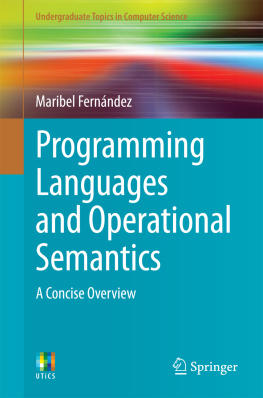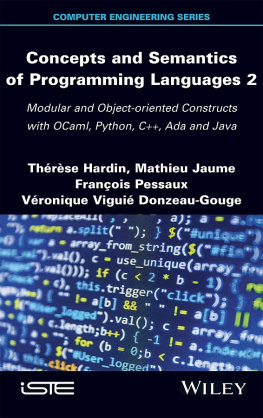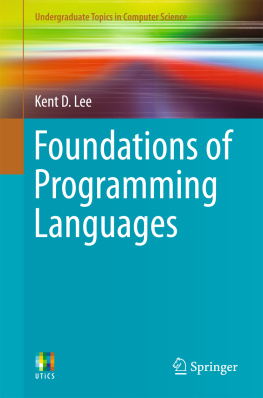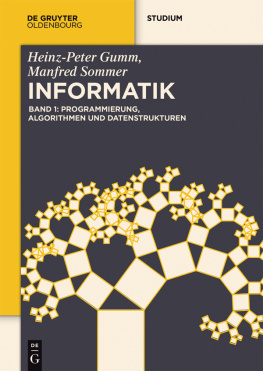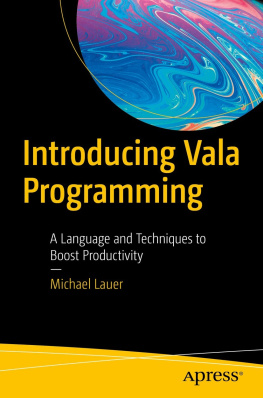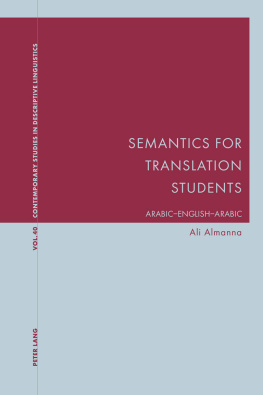Informatik. - Programming languages and operational semantics: a concise overview
Here you can read online Informatik. - Programming languages and operational semantics: a concise overview full text of the book (entire story) in english for free. Download pdf and epub, get meaning, cover and reviews about this ebook. City: London, year: 2014, publisher: Springer London, genre: Home and family. Description of the work, (preface) as well as reviews are available. Best literature library LitArk.com created for fans of good reading and offers a wide selection of genres:
Romance novel
Science fiction
Adventure
Detective
Science
History
Home and family
Prose
Art
Politics
Computer
Non-fiction
Religion
Business
Children
Humor
Choose a favorite category and find really read worthwhile books. Enjoy immersion in the world of imagination, feel the emotions of the characters or learn something new for yourself, make an fascinating discovery.
- Book:Programming languages and operational semantics: a concise overview
- Author:
- Publisher:Springer London
- Genre:
- Year:2014
- City:London
- Rating:3 / 5
- Favourites:Add to favourites
- Your mark:
- 60
- 1
- 2
- 3
- 4
- 5
Programming languages and operational semantics: a concise overview: summary, description and annotation
We offer to read an annotation, description, summary or preface (depends on what the author of the book "Programming languages and operational semantics: a concise overview" wrote himself). If you haven't found the necessary information about the book — write in the comments, we will try to find it.
Informatik.: author's other books
Who wrote Programming languages and operational semantics: a concise overview? Find out the surname, the name of the author of the book and a list of all author's works by series.
Programming languages and operational semantics: a concise overview — read online for free the complete book (whole text) full work
Below is the text of the book, divided by pages. System saving the place of the last page read, allows you to conveniently read the book "Programming languages and operational semantics: a concise overview" online for free, without having to search again every time where you left off. Put a bookmark, and you can go to the page where you finished reading at any time.
Font size:
Interval:
Bookmark:
Preliminaries
- understand the differences between apparently similar constructs in different languages;
- be able to choose a suitable programming language for each application;
- increase our ability to learn new languages and our ability to adapt to changes in existing languages;
- design new languages (not just programming languages: the general concepts underlying programming language design can also be applied to the design of other kind of languages, for instance, software modelling languages, languages to specify security policies, or user-interfaces for software applications).
- Older languages such as Fortran (the first version was reported in 1954 []) do not support any specific design method.
- More modern languages were designed to support a specific design method: for example, Pascal [] supports object-oriented design and programming.
- Imperative Languages : Programs are decomposed into computation steps (also called commands, statements, or instructions), reflecting the step-wise execution of programs in usual hardware. Subprograms (also called routines, procedures, etc.) are used to build programs in a modular way. Programs written in imperative languages give accurate descriptions of how to solve a given problem. For example: Fortran, Algol [] and Java are imperative languages.
- Functional Languages : Programs are functions, which can be composed to build new functions as in the mathematical theory of functions (the basis of these languages). This class of languages is also called declarative, since the focus is on what should be computed, not how it should be computed. Functional languages emphasise the use of expressions, which are evaluated by simplification. For example: Haskell, SML [], introduced by John McCarthy in the 1950s, is considered to be the ancestor of all functional programming languages.
- Object-oriented Languages : Programs are collections of objects which can only be accessed through the operations (or methods) provided for them, and are usually hierarchically organised. For example: Java and Python are object-oriented languages. An object can be thought of as an entity combining data (fields) and operations (methods). In the object-oriented design methodology, the designer produces a hierarchical description of the structure of the system, which is the basis for the implementation in an object-oriented language. Object-orientation is sometimes considered as a feature of imperative languages, however, it can also be found in functional languages and it can be combined with logic languages too. Therefore we see it as a paradigm of programming in its own right. However, this class of languages is out of the scope of this book.
- Logic Languages : Programs describe a problem rather than defining an algorithmic implementation. Again this class of languages is declarative, since the focus is on the specification of the problem that needs to be solved and not on how it is solved. A logic program is a description (usually using the language of first-order logic) of facts and properties about a problem. The most well-known logic programming language is Prolog [], which was designed by Colmerauer, Roussel and Kowalski in the 1970s. More modern logic programming languages combine logic programming and constraint-solving.
Font size:
Interval:
Bookmark:
Similar books «Programming languages and operational semantics: a concise overview»
Look at similar books to Programming languages and operational semantics: a concise overview. We have selected literature similar in name and meaning in the hope of providing readers with more options to find new, interesting, not yet read works.
Discussion, reviews of the book Programming languages and operational semantics: a concise overview and just readers' own opinions. Leave your comments, write what you think about the work, its meaning or the main characters. Specify what exactly you liked and what you didn't like, and why you think so.

